

Researchers at Oak Ridge National Laboratory are using state-of-the-art methods to shed light on chemical separations needed to recover rare-earth elements and secure critical materials for clean energy technologies.
Bastnäsite deposits in the United States are rich in rare-earth metals but must be mined and separated from unwanted minerals through chemical processes that are not well understood. Fundamental insights are needed to improve current recovery approaches based largely on trial and error. Greater efficiency offers cost-savings as well as benefits to the environment by decreasing mining and carbon impacts.
“The path forward will require predictive modeling to help us discover the best candidates for more efficient separations,” said ORNL’s Vyacheslav Bryantsev.
The team combined theory and spectroscopy methods to design collector molecules that buoy bastnäsite out of an ore mixture to enhance recovery by froth flotation. Their study, published in Langmuir, supplies missing information for modeling future collectors tailor-made for efficient separations.
New path to rare earth mineral formation has implications for green energy and smart tech
Robert C. Chapleski et al, Improving Rare-Earth Mineral Separation with Insights from Molecular Recognition: Functionalized Hydroxamic Acid Adsorption onto Bastnäsite and Calcite, Langmuir (2022). DOI: 10.1021/acs.langmuir.1c03422
Oak Ridge National Laboratory
Citation:
Researchers working to recover rare-earth elements and secure critical materials for clean energy technologies (2022, June 2)
retrieved 2 June 2022
from https://phys.org/news/2022-06-recover-rare-earth-elements-critical-materials.html
This document is subject to copyright. Apart from any fair dealing for the purpose of private study or research, no
part may be reproduced without the written permission. The content is provided for information purposes only.

